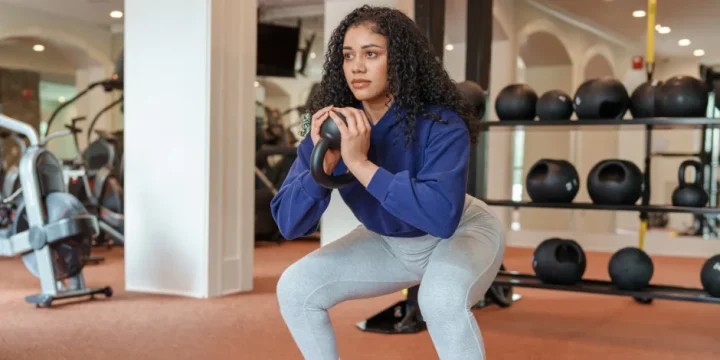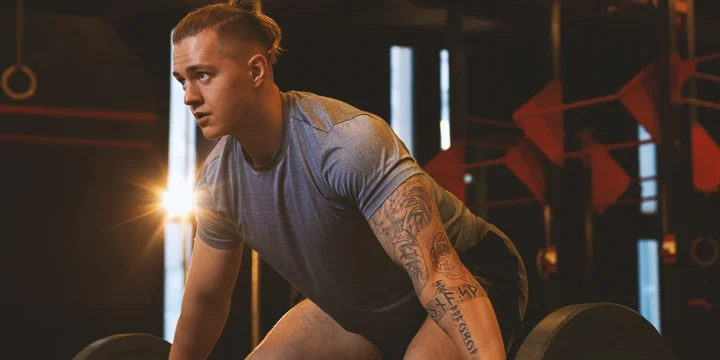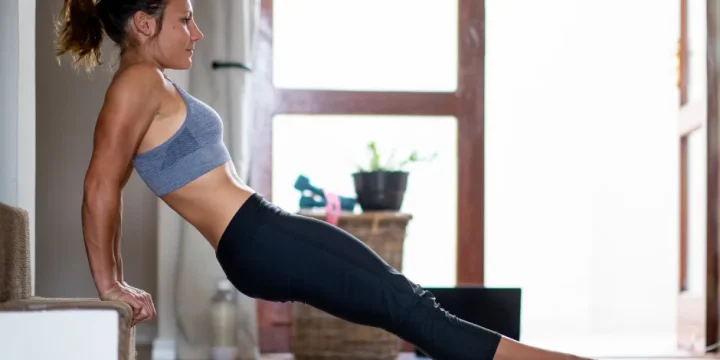As a personal trainer, clients ask me which program is the best for achieving strength and muscle mass.
After much research and experience, I've found that powerbuilding - combining the muscle-building techniques of bodybuilding with the strength-focused exercises of powerlifting - allows you to get the best of both worlds.
So, I spent hundreds of hours researching to carefully craft a powerbuilding program to help you reach your fitness goal.
Quick Summary
- Powerbuilding program involves a 4-day-per-week training split, focusing on both upper and lower body workouts to ensure balanced development.
- There are multiple ways to structure your powerbuilding program, such as the pull/push/leg or body part training split.
- Research from the National Library of Medicine suggests that increasing training frequency to four times per week is key for muscle strength for intermediate gym-goers.
- Personally, I found that a quality pre-workout supplement can help you perform at peak capacity in your powerbuilding workout routine.
4-Day-Per-Week Powerbuilding Program
Monday - Lower Body

In my own 4-Day-Per-Week Powerbuilding Program, I kick off Mondays with a focus on the lower body. My routine starts with deadlifts, which has been pivotal in building my foundational strength.
Deadlift - 3x5 (heavy)
To perform deadlifts:
- Stand with feet hip-width apart and the bar facing you.
- Place your hands on the bar with a shoulder-width grip.
- Slightly bend the knees, hinge your hips backward while keeping your back and torso straight.
- Lift the bar by extending your hips until you are standing straight.
- Slowly lower the bar back down to return to the starting position.
- Repeat for the desired number of repetitions.
Barbell Front Squat - 3x5 (heavy)
To do barbell front squats:
- Set up the barbell with your preferred weight.
- Hold the barbell with a clean grip, stand with the feet hip-width apart and toes slightly pointed outwards.
- Squat down while keeping your chest up.
- Push through the heels to stand up again and return to the starting position.
- Repeat for three sets of eight reps.
Leg Press - 3x8 (moderate)
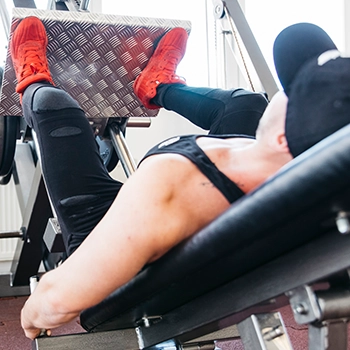
To do the leg press:
- Set the machine to a weight you can find comfortable but challenging.
- Drive through your heels to press the footplate away.
- Bend your knees to lower the footplate towards your body slowly.
- Repeat for three sets of eight reps
Leg Extension - 3x8 (moderate)
To do the leg extension:
- Sit down on the machine and grab the handles for support.
- Extend your legs to raise the padded bar.
- Pause for three seconds before lowering the padded bar to return to the starting position.
- Repeat for three sets of eight reps.
Leg Curl - 3x8 (moderate)
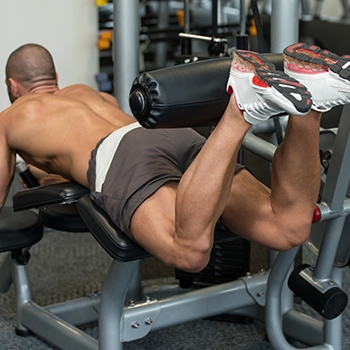
To perform the leg curl:
- Lay face down on the bench with your feet and lock your feet under the ankle pad and hands grasping onto the handles for support.
- Pull your legs towards your buttocks while keeping your hips flat against the machine.
- Hold for 3 seconds before slowly lowering your legs back to the starting position.
- Repeat for the desired number of reps and sets.
Calf Raises - 3x15 (moderate)
To do calf raises:
- Adjust the footplate and shoulder pads of the calf raise machine to fit your height.
- Place your shoulders under the pads, stand up with your feet hip-width apart on the footplate, and position your toes facing forward.
- Slowly raise your heels while squeezing your calf muscles, keeping your knees extended.
- Hold for one to three seconds when you’re standing on tiptoes.
- Slowly lower your heels down to the starting position.
- Repeat until you reach the desired number of reps.
“Modifying the way you place your feet changes the muscles worked. Turn the toes inward slightly and you'll work the inner calf muscles more; turn them outward slightly and you place more tension on the outer calf muscles.”
- Chelsea Evers, Fitness Editor
Tuesday - Upper Body

Bench Press - 3x5 (heavy)
To do the bench press exercise:
- Grab two dumbbells and lay on a flat bench with the feet planted on the floor.
- Place the dumbbells at your chest level.
- Slowly extend your arms to lift the dumbbells.
- Hold for three seconds before lowering the dumbbells to return to the starting position.
- Repeat until you reach the desired number of reps.
Incline Dumbbell Bench Press - 3x8 (moderate)
To do the incline dumbbell bench press:
- Sit on an incline bench at a 45-degree angle.
- Grab a dumbbell in each hand, place it on your thighs.
- Lift the dumbbells using your legs and bring them to your chest level with your palms facing forward.
- Lay back on the bench and fully extend your arms to press the dumbbells.
- Pause for three seconds before slowly lowering the dumbbells to your chest level.
- Repeat the exercise until you reach the desired amount of sets and reps.
Pull Up - 3x8 (moderate)
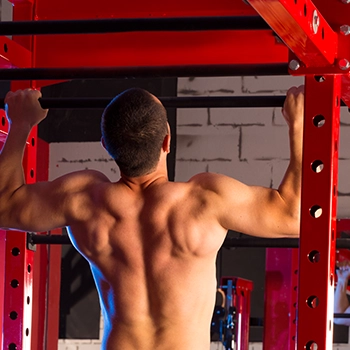
To do the pull-ups:
- Hold a pull-up bar with your hands slightly wider than your shoulder width apart.
- Move your feet away from the ground or step to hang from the bar.
- Bend the elbows to pull your body up until your chin reaches the bar, keeping your torso up and engaging your core muscles.
- Hold for a second before slowly lowering back.
- Repeat until you reach the desired number of reps and sets.
Seal Row - 3x8 (moderate)
To do seal rows:
- Lay face down on a flat bench with a bar placed below you on the ground.
- Place hands on the bar with a slightly wider than shoulder-width grip.
- Inhale as you lift the weights towards your chest, squeezing your shoulder blades together, keeping your elbows tucked in close to your sides.
- Exhale as you lower the weights back.
- Repeat until you reach the desired number of reps and sets.
Barbell Curl - 3x8 (moderate)
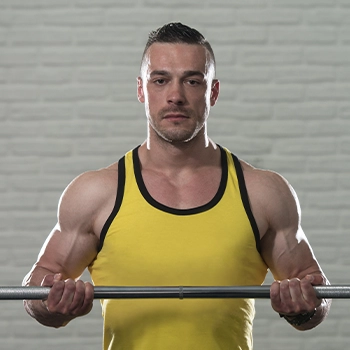
To perform barbell curls:
- Hold a barbell with an underhand grip and stand with your feet hip-width apart.
- Inhale as you curl the barbell towards your chest, squeezing your biceps.
- Exhale as you lower the barbell to return to the starting position.
- Repeat until you reach the desired number of reps and sets.
Skull Crusher - 3x8 (moderate)
To do skull crushers:
- Lay down on a flat bench with your feet planted on the floor.
- Hold a barbell shoulder-width apart and extend your arms toward the ceiling.
- Bend your elbows to lower the weight towards your forehead slowly.
- Slowly raise your arms back to return to the starting position.
- Repeat until you reach the desired number of reps and sets.
“Keep a firm grip to keep the weight from accidentally slipping from your hands and potentially causing damage or injury to your head or face. If this is a concern, you may want to increase your grip strength before performing this exercise.”
- Paul Rogers, Fitness Expert
Thursday - Lower Body
- Deadlift - 3x5 (heavy)
- Barbell front squat - 3x5 (heavy)
- Leg press - 3x8 (moderate)
- Leg extension - 3x 8 (moderate)
- Calf raises - 3x12 (moderate)
- Leg curl - 3x12 (moderate)
Friday - Upper Body

- Barbell curl - 3x8 (moderate)
- Skull crusher - 3x8 (moderate)
Weighted Plank - 3x30 (moderate)
How to the weighted plank:
- Get in a plank position and have a training partner place a weighted plate on your back.
- Hold the plank position for thirty seconds, keeping your body straight.
- Repeat until you finish three sets.
Cable Crunch - 3x15 (moderate)
How to do the cable crunch:
- Set up a cable machine with a rope attachment at a high position.
- Kneel facing the machine, hold the rope with both hands behind your head, and bring your hands to your face with your elbows bent.
- Allow the weight to arch your back.
- Engage your abs and curl your torso down towards your thighs.
- Hold for a moment and slowly release back up. Keep your hips stationary and focus on contracting your abs with each rep.
- Repeat until you finish three sets of fifteen reps.
Pallof Press - 3x15 (moderate)
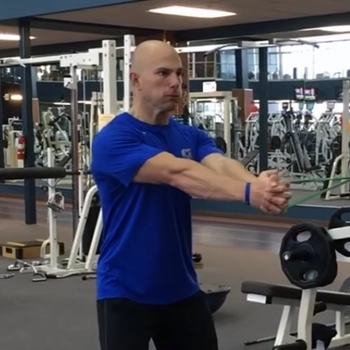
How to do the Pallof press:
- Attach a handle to a cable machine at chest height.
- Stand tall with your side facing the cable machine and hold the handle with both hands.
- Take a few steps away to create tension and bring the handle to your chest.
- Hold for a few seconds before slowly extending your arms away from your chest to return to the starting position.
- Perform three sets of fifteen reps then switch sides.
Hammer Curl - 3x8 (moderate)
How to do the hammer curl:
- Grab a dumbbell in each hand, then stand with your feet shoulder-width apart.
- Slowly raise the dumbbells towards your shoulders.
- Hold for three seconds, then lower the dumbbells to return to the starting position.
- Repeat until you reach the desired amount of reps.
Triceps Extension - 3x8 (moderate)
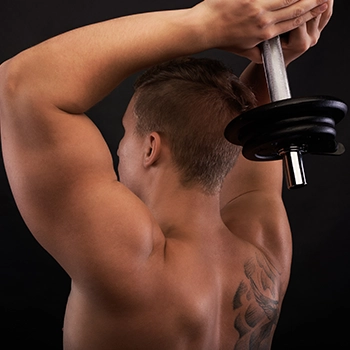
How to do the triceps extension:
- Hold a dumbbell and stand with your feet shoulder-width apart.
- Extend your arms to lift the dumbbell overhead.
- Lower the dumbbell behind your head in a controlled manner.
- Hold for a second and lift the dumbbell back to the starting position.
- Repeat until you finish three sets of eight reps.
Which Powerbuilding Split is Best For You?
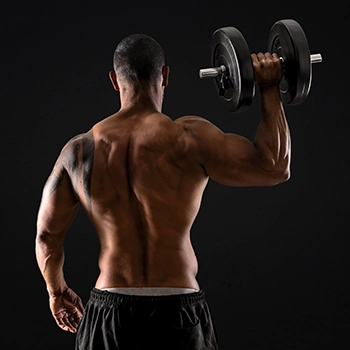
The best powerbuilding split for you depends on your ability to handle heavy training.
A beginner getting into powerbuilding need to focus on consistent training three times a week, with a greater emphasis on compound exercises or lifts that include the movement of more than one joint.
According to a study in the National Library of Medicine, for intermediate gym-goers, increasing training frequency to four times per week and incorporating additional variation and difficulty into their workout programs is key for muscle strength [1].
As an advanced lifter myself, I've found that training five days a week strikes the perfect balance. It's not just about adding weight each session; it's about listening to my body and adjusting the volume and intensity, which has helped me avoid burnout and injuries.
How to Organize Your Powerbuilding Workout Split?
You can organize your powerbuilding workout split based on either the push training or pull training (for the advanced), upper/lower body workout (for beginners), or a body part split (for the advanced).
To know how to structure powerbuilding workouts, you must first understand that you must include the big lifts.
These include:
- Squats
- Deadlifts
- Bench Press
- Overhead Press
In addition to these exercises, you should add accessory lifts to your training routine.
The formats of these workouts can differ, aside from the need for the big compound exercises at low rep range and accessory exercises or other multi-joint lifts at mid rep range.
Related Articles:
What Are the Benefits of Powerbuilding?

The benefits of powerbuilding are improved strength, physical appearance, and muscle gains.
Since I started powerbuilding, my strength has noticeably improved – I've gone from struggling with basic lifts to confidently adding more weight each week. Additionally, the changes in my physical appearance have been remarkable and motivating.
Here are all the powerbuilding benefits:
- Helps grow lagging muscles - Powerbuilding can help grow lagging muscle groups; incorporating a hypertrophy training day each week dedicated solely to these muscle groups will help you correct any muscular imbalance.
- Strength matching muscles - Powerbuilding helps to match strength with muscle growth, making it a well-rounded and multi-approach to training.
- Offers variety in exercises - The variety of exercises within powerbuilding training sessions allows different lifts and movements to be incorporated while varying the set and rep ranges.
- Split Training - Many powerbuilding programs use splits, where both upper and lower body muscles are targeted twice a week, allowing for a good volume for all major muscles without over-training.
Top Tips to Maximize Strength on Your Powerbuilding Routine

Following the tips below, you can train smarter and more effectively to get the most out of a powerbuilding training style.
- Take longer rest periods in between sets on your power days to recover and be ready for your next set. According to a PubMed study, longer rest periods are proven to improve strength and hypertrophy [2].
- Prioritize proper form over the amount of weight you lift. This means adopting a strength-first mentality during your power-focused workouts, which should occur before your hypertrophy days each week.
- Avoid training to absolute failure every single set. The research has shown that sets taken to non-failure are just as effective as sets taken to failure for muscle hypertrophy and strength [3].
- Switch up exercises from time to time. While variations of squats, deadlifts alternatives, and bench presses should always be included on your power days, adding variety can keep your muscles guessing and prevent boredom [4].
- Add weight to the bar as the weeks go on power days, or incorporate intensity techniques to progress.
“Adequate rest between sets helps to maintain a high level of force production for the next set. Thus, typical rest periods for increasing strength are between 2–5 minutes, which research shows to be optimal for strength development.”
- Travis Edwards, Physical Therapist
Nutritional Guidelines for Powerbuilding
Here are the nutritional strategies that complement the physical demands of powerbuilding.
- Caloric intake: To support muscle growth and recovery, you typically need a caloric surplus – consuming more calories than you burn. A good starting point is to add an extra 250-500 calories to your daily maintenance calories.
- Proteins: Are crucial for muscle repair and growth. Aim for 1.2 to 2.0 grams of protein per kilogram of body weight. Focus on high-quality sources like lean meats, fish, eggs, dairy, and plant-based options like lentils and tofu.
- Carbohydrates: Carbs fuel your workouts and aid in recovery. The recommendation is 3-6 grams per kilogram of body weight, focusing on complex carbohydrates like whole grains, fruits, and vegetables for sustained energy.
- Fats: About 20-30% of your total caloric intake should come from fats, with a focus on unsaturated sources like nuts, seeds, avocados, and olive oil.
- Hydration: Water supports metabolic functions and nutrient transfer, and it helps regulate body temperature during intense workouts. Aim for at least 3 liters of water per day, more if you are training intensely or in hot conditions.
FAQs
What Are the Best Exercises to Include In Any Powerbuilding Workout?
The best exercises to include in any powerbuilding workout are deadlifts, squats, and bench presses.
How Many Days Should You Lift Per Week to Increase Strength and Muscle Mass?
You should lift each major muscle group at least twice a week to increase strength and muscle mass. While performing push compound lifts - like the bench press and the overhead press - in a single training session can help you get bigger gains, a two to three times training frequency is the most effective.
Is Powerbuilding Safe?
Yes, powerbuilding is safe if it’s performed with the appropriate form and technique and proper safety measures are taken. Always use well-maintained gym equipment and never skip warm-ups to avoid injuries.
References:
- https://www.ncbi.nlm.nih.gov/pmc/articles/PMC6081873/
- https://pubmed.ncbi.nlm.nih.gov/26605807/
- https://www.ncbi.nlm.nih.gov/pmc/articles/PMC7725035/
- https://www.ncbi.nlm.nih.gov/pmc/articles/PMC6934277/
About The Author
You May Also Like

